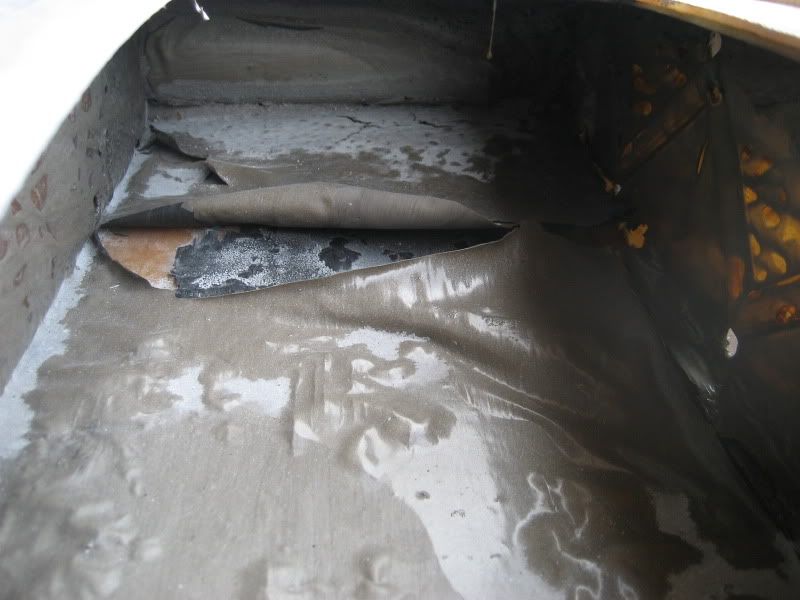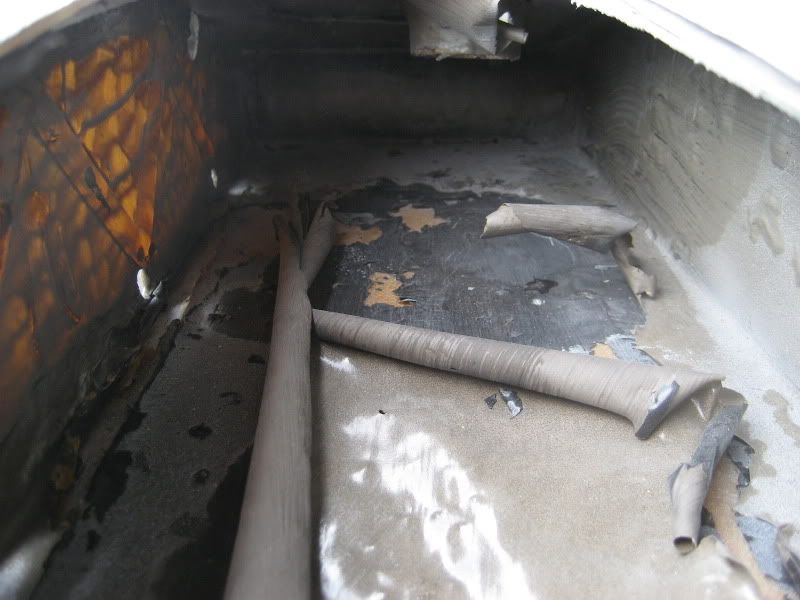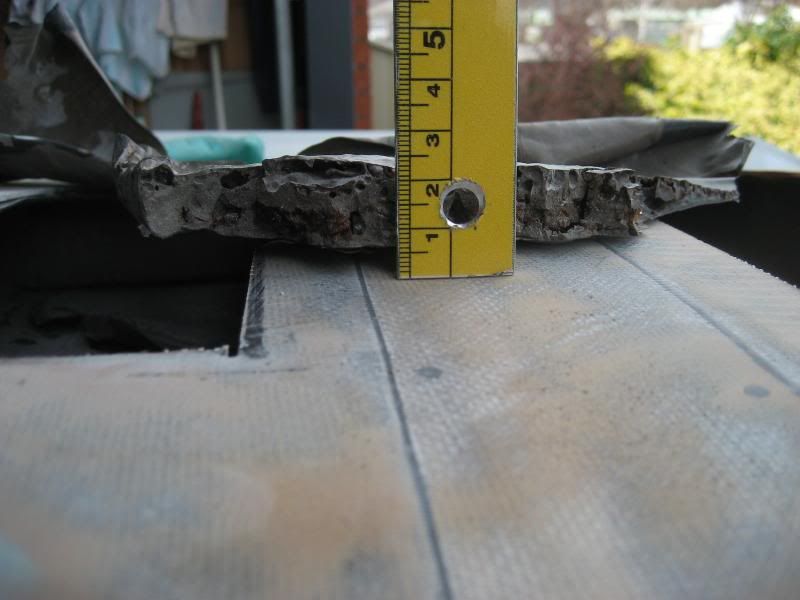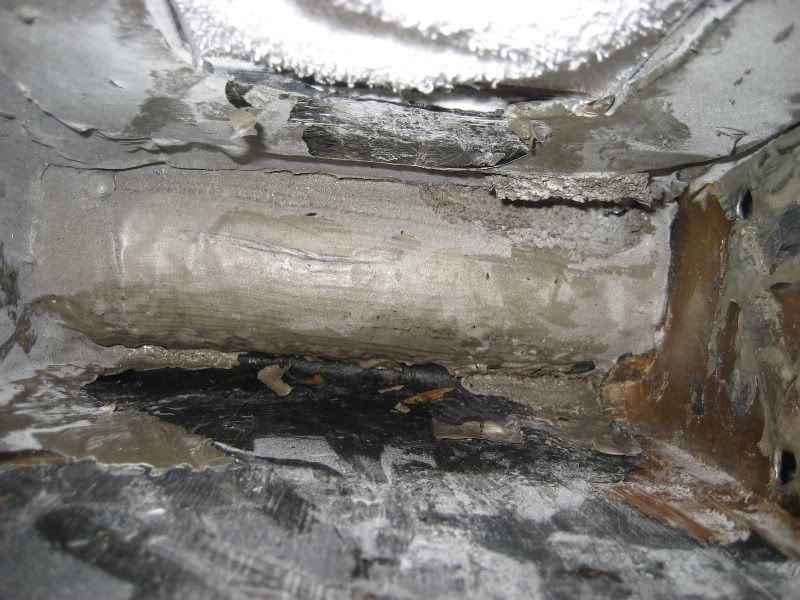|
|
Post by Dave.K on Sept 19, 2011 21:38:28 GMT 12
Hi, Our beloved Avid is determined not to let the new aviator get airborne. After fixing the fuel tank leak and redoing the fabric and painting, it was found to have floating stuff in the fuel tank. The decision was made to cut open the top of the fibreglass tank to find a heap of sloshing sealer had delaminated. we are now in the process of cleaning out the tank and reglassing the top patches. The aircraft has only one tank so no redundancy, this could have been potentially fatal had we not found it. The tank is in good condition with no flaking of the fibres. No log exists of when the sealer was put in the tank, so it isn't known what type of fuels have been put in to start the delaminating process, like the ethonal / methonal based fuels. If you know of any aircraft with a fibreglass tank with sloshing sealer inside I suggest it be inspected as soon as. Cheers dave.      |
|
|
|
Post by Bruce on Sept 19, 2011 22:52:39 GMT 12
I have heard about it happening overseas - a fellow builder of a Skystar Vixen (an Avid derivative)has heard about it on the Skystar online forums. The Skystar (and probably Avid) had the sloshing compound applied by the factory as the tanks aren't fuel resistant resin, and they initially also had porosity problems.
Seems a lot of the US Builders are now going to tanks made in fuel resistant resin without sloshing sealant. Its some kind of reaction between the sealant and the resin.
I trust you filled in a CAA defect report and sent it to CAA - its really important to report these issues to determine the scope of the problem. I havent heard of it in NZ before this, so it certainly needs to be notified.
|
|
|
|
Post by Dave Homewood on Sept 19, 2011 23:42:36 GMT 12
As this is a safety issue I have stickied the thread. Thanks for bringing it to people's attention Dave.
|
|
|
|
Post by harvard1041 on Sept 20, 2011 0:04:00 GMT 12
|
|
|
|
Post by lumpy on Sept 20, 2011 7:24:34 GMT 12
A similar product is / was commonly used to seal the insides of rusty steel fuel tanks as well . It is only marginally sucessful as the preperation of the inside of the tank is difficult . Not only that , the failure rate jumped dramaticly when unleaded fuel was introduced . It seemed as though the additives added to petrol to replace the lead didnt "like " the sealer .I believe the sealers still in use ( usually white in colour )are a different formular to the earlier ones ( usually black ) .
I should piont out that my experience is with motorbikes , not aircraft - just thought it might be of some interest .
|
|
|
|
Post by Dave.K on Sept 20, 2011 21:47:01 GMT 12
Thanks guys,form done, been e-mailing Bob Jelley as well, probably will be an article in the Vector magazine.
|
|
|
|
Post by baronbeeza on Sept 20, 2011 22:26:51 GMT 12
Certainly a mess. I have seen many tank sealant jobs... been inside a 737 tank (inside the wing-literally), done a Cresco right down to tip tank repairs on a C402B. Some like the Saab have brilliant access and you can get a real tidy job. Most certified aircraft would have PRC 1422 or similar as a sealant and then sloshed or finished with 1005.
I have had to deal with a minor leak on a Fokker 100 recently but again the access was very good. If the sealant is applied at all correctly then you would see little delamination.
Of course these would be Certified aircraft and with metal tanks, a little different I accept.
'''''''' No log exists of when the sealer was put in the tank, so it isn't known what type of fuels have been put in to start the delaminating process, like the ethonal / methonal based fuels. '''''
Must make life difficult also, hard to believe the lack of a log entry.. unheard of on a certified machine again.
I am actually flabbergasted, - my experience of delaminating sealant is a feather edge lifting, possibly a few loose flakes in the filter after a tank disturbance.
This is major and you would be relieved to open the tank up and catch this in time. It will make for a tidy repair job also, - (and a lighter machine...).
|
|
|
|
Post by Bruce on Sept 20, 2011 23:21:34 GMT 12
I've done some research on the US instances of delamination - the cause is considered to be Ethanol blended automotive fuel (Mogas). the cans of the sloshing sealer come with a warning not to use with alcohol - blended fuels. the problem is, a lot of Fibreglass tanks had the sealant applied in the factory before Blended fuels were introduced, and owners dont know whats inside them, nor are any warning placards etc supplied. You also cant tell whether the Mogas you are putting in at any particular time has Ethanol in it. It could be up to 15%, but Petrol stations dont have to label it. definitely something to watch out for.
|
|
|
|
Post by Dave.K on Sept 21, 2011 20:17:25 GMT 12
Thanks Bruce, appreciate your efforts,also baronbeeza for the input, there is a lot of knowledge around here. Have you seen this grey type sealer before? the vans site further up says they used white or red, I have seen clear randolph sealer, which was quite runny, this looks like it was thick when poured in the tank, and with the lip on the filler neck a lot was left in which settled at the back (lowest edge) and was up to 25mm thick. Once we get the tank clean we plan to cover it in fuel resistant resin, glass the cutouts back in, so it will be good for a long time.
|
|
|
|
Post by baronbeeza on Sept 22, 2011 9:52:10 GMT 12
It would make sense. PR-1422 is very thick and can be a mongrel to apply. It really is the ultimate s**t to a blanket stuff. It is just one of a group of similar sealants... mostly known under a range of names such as Semkit, Proseal and Thiokol. The guys that work on heavier level maintenance will know all about it and should be able to chip in. www.chemcenters.com/images/DATA%20SHEET/PR%201422%20B1-2.pdfwww.aerospace-acc.com/ACC/products.asp?category=SealantA few things to note; It is expensive. It has a shelf life. It is difficult to store once made up. It is hazardous. The code suffixes denote application time and 'runniness'. I have seen it thinned with MEK for brushing into tricky places on the airframe. ie around cargo door areas where the switches and brackets are subjected to the weather elements. So PR-1422 is typical of the old story, real nasty stuff but does a very good job. It is normally brilliant as nothing will touch it.... MEK is used to remove it but that is never easy either. This poser was posted on a C-130 Hercules forum.. '''''''''''''' PR 1422 B2 for fuel tank sealing is there any chemical reaction if my sealant PR 1422b2 mixed with METHEL ETHEL KETONE ( M E K ) ? i have run out of PR 1422 A2,, so i used B2 and mixed with small amount of MEK ( METHEL ETHEL KETONE) just to less the viscosity.. is there any problem with this? pls advice because my supervisor is too much worry about this,, thanks... by the way im using in fuel tank bladder cell plunge. '''''''''''''''''''' The supervisor would be concerned obviously ... He is certifying for the job. In the case of your Avid there is no log entry,- draw your own conclusions.. If you look at my list of characteristics above you can see that by using the slightly wrong product the job can still be done. It could be Time-ex, wrong spec, wrong application time or viscosity. It may even have been applied incorrectly, - but it sure was an abortion. Any of these could cause your delamination issues I guess. The use of mogas has to be considered but these PRC would have to be more resistant to attack than most common automotive components. You would normally expect to see the sealant brush finished or sloshed with PR-1005L. I didn't see any sign of it in your tank. It is the red varnish type liquid and is much easier to apply. www.hutchinson.ch/tds/en/pdf/pr1005l.pdfwww.silmid.com/Products/Sealants/PPG-Aerospace-Sealants/PPG-Fuel-Tank-Sealants/1005L00050.aspxWell there we are, I just noticed 1005 is not used on Mogas fuels.. well I never. What is in the modern car gas ?? |
|
|
|
Post by baronbeeza on Sept 22, 2011 14:16:48 GMT 12
|
|
|
|
Post by Dave.K on Oct 3, 2011 18:31:26 GMT 12
|
|
|
|
Post by Dave.K on Feb 22, 2012 20:31:58 GMT 12
|
|
|
|
Post by shorty on Apr 5, 2012 19:59:02 GMT 12
There is an article in the latest Vector regarding this problem
|
|
|
|
Post by Dave.K on Apr 5, 2012 21:17:32 GMT 12
Thanks Shorty, had a bit of input in to it. Good to get the message out there.
|
|
sluf7
Squadron Leader
  
Posts: 106
|
Post by sluf7 on Mar 8, 2013 23:50:20 GMT 12
Bummer nice repair work.
|
|

